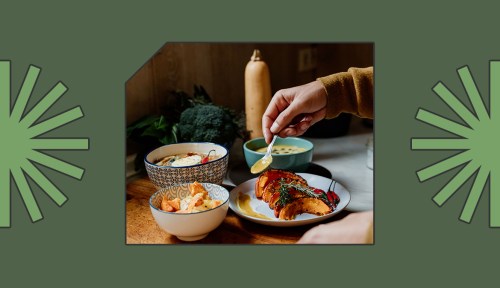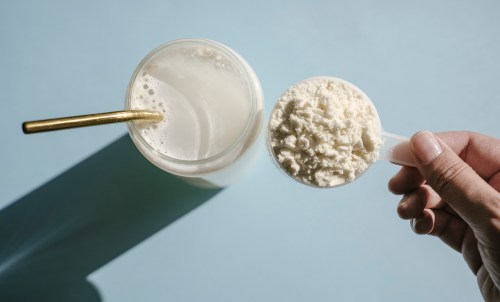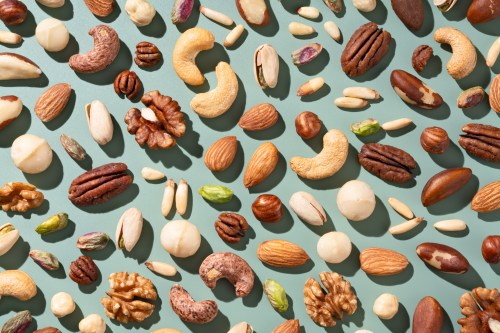Our editors independently select these products. Making a purchase through our links may earn Well+Good a commission
Solidifying a new food routine takes time, but you’ve already made so much progress on your mission to incorporate a wider variety of flavor-filled, nutrient-dense dishes and plants into your pattern of eating. Over the course of this month, we’ve worked together to amplify and expand how we think about healthy foods without feeling the need to “healthify” the cultural foods you already love—and that deserves a pat on the back.
Experts in This Article
registered dietitian and nutritionist
I often tell my patients that we’ve been eating since we were six months old, so it makes sense that we have a particular relationship with food. We’re human beings; we like routine. But now that we’ve successfully (and deliciously, and healthfully) escaped our food rut, we can officially move onto developing an action plan for staying there.
Indeed, our last week together will serve as the road map for longevity. We will focus on replicating new nutrition behaviors like keeping a well-stocked pantry, meal-prepping, continuing to shop all parts of the grocery store, infusing flavor, and including global foods in your pattern of eating. What’s more, you can get a copy of my cookbook Eating From Our Roots this week and use it as a road map to further explore flavors from around the globe from the comfort of your kitchen. You may even find some new favorites that will become a part of your routine all year long. Cheers to that!

Day 22: Fit five new herbs and spices into your spice rack
As you’ve likely noticed, herbs and spices have played a big role every week throughout this month. This is no coincidence: Cooking with these seasonings truly is one of the simplest (not to mention most affordable and effective) ways to amplify the flavor, texture, and nutrient-density of your dishes, particularly those that center vegetables.
In Eating From Our Roots, I use herbs and spices as the culinary vehicle for travel and exploration without leaving your kitchen. Today, I’m challenging you to do the same by allowing your palate to experience something new. A great way to go about this is by adding five new types of herbs and/or spices to your spice rack. (You should have plenty of extra room to accommodate them after tossing out your expired spices earlier this month, after all).
To help you discern which flavors you’ll likely enjoy most, I encourage you to expand by region. If you find that you are enjoying Haitian food, explore the tastes of Haiti by region and let your spice cabinet follow. This may mean buying (or DIY-ing) Haitian epis, a traditional Caribbean seasoning made with peppers, fresh herbs, garlic, olive oil, and vinegar. If you love Thai dishes, stock up on lemongrass, green curry, and Thai basil leaves and stir them into a saute pan filled with veggies and coconut rice or noodles. If Persian food strikes your fancy, try cooking with saffron, sumac, or coriander. There are only right answers here.
Day 23: Expand your frozen food shopping list
Frozen foods have earned a bad rap for being filled with sodium and saturated fat over the years, but this is no longer the case. The freezer aisle today is home to some of the most nutritious products in the supermarket, from frozen fruits and vegetables (which get picked and flash-frozen at peak-ripeness, aka when their flavor and antioxidant capacity are at their highest) to grains, easy breakfast breads, fish and seafood, and even nutritious frozen meal options.
To that end, I recommend expanding your frozen food shopping list this week to include some of the options below:
- Frozen grains: Reach for ancient grains, whole grains, as well as quick-cooking refined grains (like rice or noodles)
- Frozen blueberries, plus any other frozen fruit your palate prefers: If you’re feeling adventurous, try using them in my blueberry bread recipe
- Frozen breakfast options: I love Evergreen Waffles and any form of potatoes I can get my hands on
- Animal proteins: Think fish and shellfish, chicken, turkey, or grass-fed beef
- Vegetable mixes: You can’t go wrong—try revisiting your list of favorite veggies from week two and trying them out in frozen form (I highly recommend frozen edamame)
- Frozen meals: Check out a dietitian’s list of gut-friendly frozen meals (and snacks) here
Day 24: Start a personal recipe book
Now that you have a few recipes under your belt and plenty of new favorite foods and flavors to cook with, it’s time to start your own recipe book. This will help you keep track of your favorite dishes and inspire you to continue cooking them for years to come.
Your personal cookbook can be crafted with pen and paper or on your computer—do what method is easiest and most effective for you. I advise you to start your recipe collection with the base dishes below:
- 3 breakfast ideas
- 3 lunch ideas
- 3 dinner ideas
- 3 snack ideas
FYI, if you do choose the digital route, know that there are a number of apps that allow you to build custom recipe journals, and some even integrate into a third-party site, such as Yummly or Whisk. Many online grocery delivery services like Instacart also have options to save your custom recipes and make them shoppable. This seamless integration allows you to curate your grocery cart based on what you plan to cook.
Day 25: Buy everything you need to make Maya’s homemade granola and stewed red beans with rice recipe
In an effort to expand your freshly-minted recipe book, we’ll be making two new recipes later this week, which means today’s the day we go back to the grocery store to stock up on ingredients.
But first, a bit about the advantages of big-batch cooking, which we’ll be trying out tomorrow. Batch preparation takes the guesswork out of what to eat for an upcoming meal (which, yes, is a godsend). Execution of this concept couldn’t be easier: Simply make any given dish in a larger quantity—for instance, double the ingredients to have double the yield—and place leftovers in the fridge for use within the week, or in the freezer for even later use.
Over the next two days, you’ll make rice and beans and homemade granola. Check out the shopping lists for each dish below:
For rice and beans:
- 1 bottle avocado oil
- 2 yellow onions
- 1 head of garlic
- 1 knob of ginger
- Green seasoning
- 2 tomatoes
- 1 bunch of fresh thyme
- 2 kabocha squashes
- 2 cans coconut milk
- 1 bag dry red beans
- 2 boxes low sodium vegetable broth
- Fresh black pepper
- 1 habanero pepper
- 2 limes
- Black rice
- 2 ripe avocados
For homemade granola:
- 18-ounce canister of rolled oats
- Vanilla extract
- 15-ounces sliced almonds
- 15-ounces crushed walnuts
- 6-ounces organic triple omega seeds mix
- 8-ounces dried unsweetened blueberries
- 8-ounces raisins
- 1 bag unsweetened coconut flakes
Day 26: Bake big-batch granola recipe so you’ll have breakfast ready every morning
Your kitchen is stocked, which means we’re officially ready to start batch-cooking. On the menu today? A supersized recipe for nutty, toasty, nutrient-rich granola that contains plant-based proteins, heart-healthy fats, fiber, and antioxidants.
You’ll notice that there is no added sugar in this dish; there is plenty of natural sweetness from the dried blueberries, but should you choose, you can add an additional sweetener of your choice. And keep in mind: If you don’t love the taste of blueberries, swap them out for dried cherries, cranberries, or diced-up figs or apricots. Same goes for the nuts—use whatever variety (cashews, macadamia nuts, peanuts, and pecans would all taste equally delicious) suits your palate.
Best part? This homemade granola will yield enough granola for a month. It’ll be blissfully waiting for you every morning at breakfast time. Just remember that the key to keeping it fresh and flavorful is storing it in an airtight container in a cool, dark spot of your kitchen.
Find the full granola recipe instructions here.
Day 27: Meal-prep Maya’s recipe for Instant Pot stewed red beans with black rice and avocado—and make extra
Yesterday we learned how to bake a big-batch breakfast recipe, and today we’ll be pivoting to meal-prepping a delicious lunch and dinner dish for the week ahead: stewed red beans with black rice and avocado. Trust me, you’re in for a real treat.
Beans and rice are a staple food in so many cultures around the world. This dish is incredibly rich in plant-based protein, fiber, and many other important nutrients including folate, magnesium, and iron. And the versatility of these two ingredients can’t be beat—you’d be hard-pressed to find a vegetable or protein source that doesn’t pair perfectly with beans and rice.
Today’s recipe is packed with flavor, thanks to aromatic herbs and spices like ginger, thyme, habanero pepper, and garlic. We’ll also be cooking with coconut milk, which is a wonderful way to add creaminess and subtle sweetness to a dish without incorporating dairy. And when paired with kabocha squash, fresh avocado slices, and a squeeze of lime juice, the vibrant flavor of the red beans and black rice that serve as the base of this dish is like nothing you’ve ever tasted. What’s more, everything comes together in your Instant Pot, which means you can set it and forget it.
As soon as the stew is ready, serve yourself a bowl, and allow your leftovers to cool off before transferring them to airtight food storage containers. Store in the fridge for up to a week, or freeze your leftovers to have homemade meals at the ready for months ahead.
Find the full recipe for Instant Pot stewed red beans with black rice and avocado here.
Tip 28: Begin buying snacks in bulk and using reusable containers for storage
On our final today together, we’ll be celebrating and simplifying snacks by applying what we’ve always learned about the handiness of prepping ahead to what we eat in-between meals.
I get it: Snacks can be one of the harder areas to navigate. A lot of my patients tell me that this is where they need creative ideas for nourishing items that have crunch and flavor. This is where my love for meal-prepping comes in: I’m a big fan of purchasing snacks in bulk and then packaging them yourself at home to have at the ready when you need a midday nosh. It’s a cost-saving mechanism that also allows you to craft your own interesting, delicious, and nutrient-rich flavor combinations.
To get started, you’ll need some reliable reusable containers, which are a more sustainable option than single-use plastic baggies. You can upcycle glass jars, or purchase silicone bags like Stashers that come in a variety of sizes. Then try out some of the tasty combinations below (before sealing them up and taking them with you on the go):
- Marinate almonds in low-sodium tamari, then roast them in the oven at 350°F for 10 to 15 minutes. Voila, you have tamari almonds for a fraction of the cost
- Sunflower seeds can be lightly salted and coated with dried thyme and chili, then roasted at 350°F for 10 to 15 minutes
- For added crunch, try combining your roasted nuts with popcorn
- Purchase seaweed sheets in bulk, then toss them with mini rice cakes for an umami-rich snack
- Mix puffed ancient grain cereal with your favorite dried fruits and nuts for a crunchy twist on trail mix
Sign Up for Our Daily Newsletter
Get all the latest in wellness, trends, food, fitness, beauty, and more delivered right to your inbox.
Got it, you've been added to our email list.











